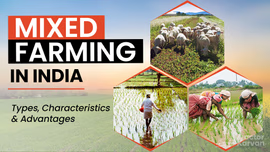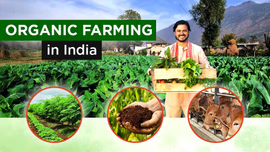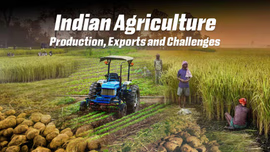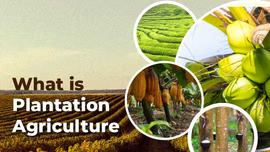DAP Fertilizer: A Solution for High-Yielding Crops

DAP Fertilizer, which stands for Di-Ammonium Phosphate, is the most common fertilizer used in India after Urea as it contains the macro-nutrients, Nitrogen and Phosphorus. It is often referred to as ’DAP Khaad’ by farmers. Read the entire blog to understand all the important aspects of DAP fertilizer, along with its uses, benefits, application, suitable crops and government initiatives to promote it.
Table of Contents
- What is DAP Fertilizer?
- When Should You Apply DAP Fertilizers?
- How to Apply DAP Fertilizers to Your Crops?
- What are the Benefits of DAP Fertilizer?
- What are the Disadvantages of DAP Fertilizer?
- Which are the Crops where DAP can be Applied?
- What are the Points to Consider while Applying DAP Fertilizer?
- What is DAP Production Scenario in India?
- What are the Government Initiatives to Promote DAP Application?
- Conclusion
What is DAP Fertilizer?
A DAP fertilizer is a common water-soluble fertilizer known for its excellent physical properties and high nutrient content. DAP fertilizer full form is Di-Ammonium Phosphate. It is rich in Nitrogen and Phosphorus, which are two major macro-nutrients and a part of 18 essential plant nutrients. The DAP fertilizer NPK ratio is 18:46:0, which falls under the high nutrient grade. It is among the most common types of fertilizers used in India as it is suitable for almost all kinds of crops.
What is Nano DAP?
A nano DAP is a liquid fertilizer that has nanoparticles and is an efficient source of Nitrogen (8%) and Phosphorus (16%) for all crops. Due to the less than 100 Nanometre (Nm) particle size, it can easily enter the seed surface or through stomata and other plant openings. Better spread-ability ensures good seed development and more chlorophyll and photosynthetic efficiency.
When Should You Apply DAP Fertilizers?
A DAP fertilizer is applied on the basis of crop and its growth. Usually, it is applied on or before the planting to provide essential nutrients to the crop for better plant establishment at the initial stage. If a crop has a longer growing season, then split applications can be done, with half of the application at the time of planting and rest during the active growth stages of the plant.
How to Apply DAP Fertilizers to Your Crops?
The application of DAP fertilizer depends upon crop growth. Usually, it is applied in the initial stages of crop development to provide essential nutrients. DAP fertilizer can be applied using various methods, including:
- Broadcasting: Equal distribution of granules over the soil surface.
- Side-Dressing: Apply fertilizer beside plant rows on different growth stages.
- Seed-Row Placement: During sowing, fertilizer should be placed in a planting row.
- Fertigation: Dissolve DAP with water and then apply it through the irrigation system.
- Drones: Now, they can also be applied precisely and remotely with the help of drones.
What are the Benefits of DAP Fertilizer?
The DAP fertilizer benefits include:
- DAP fertilizer supplies both nitrogen and phosphorus, which ensures balanced nutrient intake and the development of healthy fruits and flowers in a plant. This results in better root development and plant growth.
- DAP fertilizer helps in the development of more leaves and branches due to enough nutrient absorption. Thus, it provides a lush-looking plant.
- DAP khaad can be applied to almost all types of crops, including grains, fruits, cereals, and vegetables.
- It is dust-free and easy to store fertilizer; thus, it can be stored for a longer time.
- The regular use of phosphorus also keeps the plant free from any diseases. So, DAP fertilizers also act as disease resistant.
What are the Disadvantages of DAP Fertilizer?
Apart from the benefits, there are also some disadvantages of DAP fertilizer. Have a look at the below points:
- The excessive DAP fertilizer uses can deteriorate soil fertility.
- Its overspreading can kill many essential microorganisms present in the soil.
- It can also cause leaf chlorosis.
- It can probably lead to high water pollution and contamination.
- The presence of ammonium after the DAP granules start dissolving can absorb and damage the roots of the seedlings.
Which are the Crops where DAP can be Applied?
DAP fertilizer can be used on various crops including field crops, fruits and vegetables. Let’s have a look at list of crops where it can be used:
|
Field Crops |
Fruits |
Vegetables |
Leguminous Crops |
|
Maize |
Mango |
Tomato |
Cowpea |
|
Rice |
Citrus |
Potato |
Soybeans |
|
Wheat |
Banana |
Onion |
Alfalfa |
|
Millet |
Avocado |
Spinach |
|
|
|
Cashew |
Lettuce |
|
|
|
|
Cauliflower |
|
What are the Points to Consider while Applying DAP Fertilizer?
The following points need to be considered while applying DAP fertilizer to your crops:
Soil Testing: Soil testing is a very important step for the efficient use of DAP fertilizer. Test the soil to determine nutrient requirement or nitrogen and phosphorus content. DAP is a slightly acidic fertilizer which can lower the pH of the soil during application which is beneficial for the crops to thrive in slightly acidic conditions. Hence, also understanding soil pH level during soil testing is an important point of consideration.
Right Amount of Fertilizer Dose: The excessive use of fertilizer is not good for the crop. Always determine the right amount of fertilizer according to the crop needs.
DAP Placement: Improper spreading of DAP fertilizer can cause seedling injury. DAP should be placed below the seed, slightly to one side.
Soil Amendments: The macronutrients, Nitrogen and Phosphorus, give best result in neutral soils. So, if the soil is alkaline or has an excessive presence of calcium, then adding gypsum and leaching can help bring the soil pH value to neutral.
What is DAP Production Scenario in India?
DAP fertilizer is in great demand in India because of its high nutrient content, water-solubility and applicability to all crops. On a yearly basis, India requires 10 million tonnes of this fertilizer, but India only produced 4.34 million tonnes in 2023-24. Almost 60% of India’s DAP fertilizer need is met through imports from countries like China, Saudi Arabia, and Morocco.
In India, the leading DAP fertilizer manufacturers are IFFCO, Rashtriya Chemicals and Fertilizers Ltd (RCF), Chambal Fertilizers and Chemical Limited, Coromandel International Ltd, Fertilizers and Chemicals Travancore Ltd, and Gujarat State Fertilizers and Chemicals.
To boost DAP fertilizer production in India, the government has been launching schemes, providing subsidies, and signing agreements. Let us see in the next section.
What are the Government Initiatives to Promote DAP Application?
On 1st Jan 2025, the Union Cabinet gave the approval to extend the one-time special package on DAP fertilizer beyond the Nutrient-based Subsidy (NBS) for the period up to 31st December 2025. This will ensure the sustainable availability of DAP at affordable prices to the farmers. The total budget would be approximately up to Rs. 3,850 crores.
The government implemented One Nation One Fertilizer by introducing a single brand for fertilizer and logo under the fertilizer subsidy scheme, Bhartiya Jan Urvarak Pariyojana, in 2022 with the aim of increasing the availability of fertilizers in the market.
As part of the Atmanirbhar Bharat’s goal of achieving self-sufficiency in Fertilizers, in 2022, the Indian government signed an agreement with Senegal for mining and production of 10 lakh metric tonnes of DAP fertilizer in India.
Conclusion
DAP fertilizer is undoubtedly the best fertilizer for the plant nourishment. DAP for plants is preferred by farmers due to its high phosphorus concentration and balanced nitrogen content which gives several benefits to the crops and maintains overall plant health. The right amount of fertilizer is essential for better root development, nutrient-rich crops, and healthy fruits and flowers in a plant. Apply DAP fertilizer if you need a quick boost of phosphorus for plant growth and a readily available and affordable fertilizer option which results in improved crop yield.
Frequently Asked Questions On DAP Fertilizer: A Solution for High-Yielding Crops
1. What is a DAP fertilizer?
A DAP (Di-Ammonium Phosphate) fertilizer is a common water-soluble fertilizer, rich in Nitrogen and Phosphorus.
2. How much DAP fertilizer is needed per acre?
The amount of DAP fertilizer depends upon the crop requirements. It can range from 50-150 kg.
3. Can I mix DAP in water?
Yes, DAP is a water-soluble liquid fertilizer, so it can be mixed with water.
4. What are the disadvantages of DAP fertilizer?
The excessive use of DAP can deteriorate the soil, kill several essential microorganisms present in the soil, and cause leaf chlorosis.
5. Which fertilizer is best for flowering plants?
DAP fertilizer is the best option for the better development of fruits and flowers in a plant.
6. How to apply DAP fertilizer to your crop?
DAP fertilizer can be applied using various methods such as broadcasting, side-dressing, seed-row placement, fertigation, and drones.
7. DAP fertilizer can be applied to which crops?
DAP fertilizer is a versatile, easily available, nutrient rich and affordable option that can be applied to range of crops from legumes to fruits & vegetables.
8. What is the nutrient percentage in DAP fertilizer?
DAP fertilizer has 18% nitrogen and 46% phosphorus, which makes it a nutrient-rich fertilizer.


Related Blogs












